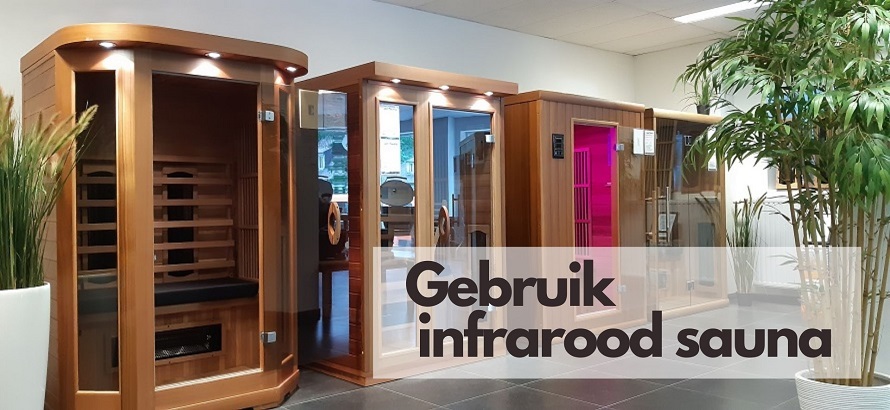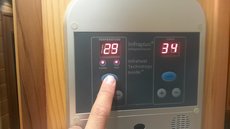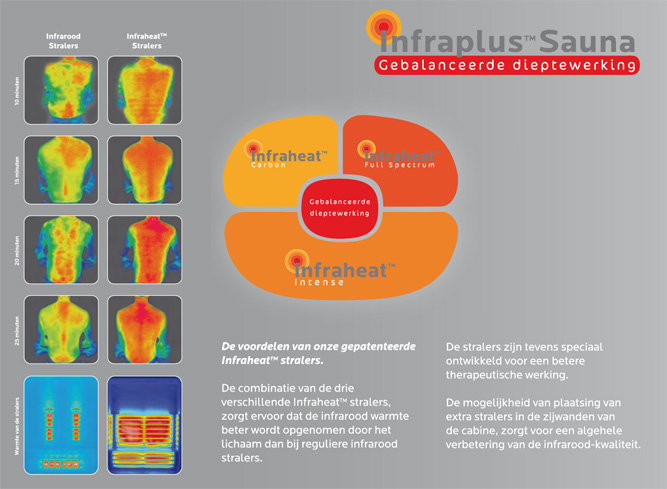How do you use an infrared sauna?


Before you start using the infrared sauna, it is important to know the purpose of using the infrared sauna. In fact, infrared saunas can be used for different purposes. Below is a list of the most common purposes:
- Pain relief for muscle and joint pain
- Relaxing, relaxing after a busy day (initial temperature is higher and final temperature too)
- Detoxifying (detoxing) the body (initial temperature is higher and final temperature too)
- Muscle recovery after exercise (initial temperature is higher but residence period is shorter because one has already completed a workout)
1. Session preparation
Before using the infrared sauna, it is recommended to drink a glass of water. In addition, to preserve the infrared sauna, it is important to put a towel on the infrared sauna's floor and bench.
2. Warm up infrared sauna
First, it is important to preheat the infrared sauna for a while before taking a seat in it. Preheating serves two purposes. Firstly, to raise the starting temperature a little so that it is pleasant to sit in the cabin (without clothing). Secondly, the infrared heaters need a few minutes to start up (with the exception of the IR-A heaters). The preheating time depends on what the user himself finds a pleasant starting temperature. Typically, the infrared sauna is preheated for between 5 and 10 minutes.


3. Infrared sauna starting temperature
The starting temperature of the infrared sauna depends on personal preference and purpose of the session. If the aim of the session is to relieve muscle and joint pains (e.g. due to rheumatic complaints), then people often choose a lower starting temperature of around 30 degrees. People who want to detox (detox) or relax in the infrared sauna will usually choose a higher starting temperature of around 35 -45 degrees. For muscle recovery, we recommend an initial temperature of around 40 degrees. An infrared sauna is thus preheated in a different way from a traditional Finnish sauna, where one heats up the sauna a long time (around 45 minutes) in advance until the sauna has almost reached its maximum temperature (around 75 degrees). The reason for this difference is easy to explain. Namely, there is a difference in heat transfer. In a traditional sauna, heat transfer is namely via the hot air. Therefore, if it is not hot, there will be no effect. With an infrared session, the temperature of the air is less important, because here we are dealing with infrared radiant heat, which is also effective at low temperatures. So if you find the traditional sauna unpleasant, you can simply use the infrared sauna at a lower temperature and still enjoy the benefits of the infrared sauna.
4. Temperature gradient during infrared session
During the session, the temperature in the infrared sauna will slowly start to rise. You should think of about 1 degree per minute. What people don't know is that it is important that the set temperature is higher than the actual temperature in the sauna. Only then does the infrared heater give off the most infrared radiant heat. So if the measured temperature in the sauna is 60 degrees, the set temperature must be at least a few degrees higher than 60 degrees!
5. Length of stay in the infrared cabin
Infrared saunas are usually used for slightly longer per session than traditional saunas. This is because the initial temperature in an infrared sauna is longer. Typically, most people use the infrared sauna for between 20 and 30 minutes. Note! Every person is different and therefore it is important to ‘listen’ to your body carefully. It is also important to build up slowly so that the body can also get used to the infrared heat. The infrared sauna may be used daily, however, it is not recommended to do a daily detox in the infrared sauna. The high temperature (above 60 degrees) in the infrared sauna could exhaust the body if used daily. People with rheumatic complaints can even use the infrared sauna twice a day (morning and evening) at a lower temperature. It is advised to simply open the door of the cabin then, so that the temperature does not get too high. The advantage is that the muscles and joints then still get the full infrared radiation heat.


6. After the session
After using it, it is important to turn off the infrared sauna and remove towels from the infrared cabin. Opening the door for good ventilation is definitely a plus. After the session, you do NOT need to rinse off cold like in a normal sauna. Just a lukewarm water and no soap or paraben-free soap.
Infrared sauna installation
An infrared sauna is a popular choice for people who want to enjoy the benefits of saunas in the comfort of their own home. When installing an infrared sauna, it is important to consider several factors. First, there should be enough space available to place the sauna, with sufficient ventilation to dissipate the heat. It is also important to have the right electrical connections to power the infrared heaters. The installation process usually involves assembling the sauna itself, connecting the wiring and testing the sauna to make sure everything works correctly. It is advisable to get help with this or have SuperSauna carry it out so that an infrared sauna is always installed safely and efficiently.
Besides installation, it is also essential to properly maintain the infrared sauna for optimal performance and durability. Regular maintenance of the infrared sauna is necessary to ensure that the emitters are working properly and to prevent any accumulation of dirt and dust. This can be done by cleaning the emitters and benches. It is important to follow SuperSauna®'s instructions regarding infrared sauna maintenance. With regular maintenance, an infrared sauna system can provide years of enjoyment and relaxation.
Some tips
- Drink plenty of water (preferred) or fruit juice before and during the session.
- While using the infrared cabin, always listen carefully to your body.
- If you find the temperature too high, simply open the door. This will keep the infrared sauna at ‘full power’ while keeping the temperature inside the cabin low.
Bronnen
https://www.ahajournals.org/doi/10.1161/str.45.suppl_1.tmp94
https://www.heart.org/en/health-topics/heart-failure/what-is-heart-failure/classes-of-heart-failure
https://www.ucsfhealth.org/conditions/heart_failure/treatment.html
https://www.ncbi.nlm.nih.gov/pmc/articles/PMC5873965/
https://www.ncbi.nlm.nih.gov/pubmed/19602651
https://www.healthline.com/health/vasodilation#causes
https://www.ncbi.nlm.nih.gov/pmc/articles/PMC4961993/
https://www.mayoclinic.org/diseases-conditions/heart-failure/diagnosis-treatment/drc-20373148

